
War memorials connect generations
WASHINGTON D.C. – John Brown of California can see a reflection of his younger self in his son and grandson.
For Brown, the faces of his offspring represent a moment in time during Brown’s life. Essentially he sees three generations of the same man separated only by time.
The faces share identical features, each set apart only by 30 years of cracks and crevices of wisdom and experience accrued over time.
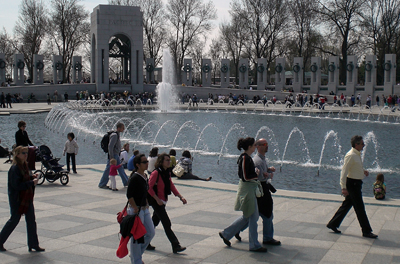 |
Visitors walk around the pool of water and fountains at the World War II Memorial (Photo by David Lake). |
The two younger faces—son and grandson—share the large distinct large forehead, the small pointy nose and the sunken dark brown eyes of the grandfather Brown.
Today, the three faces are paying homage to the oldest face at the World War II Memorial in Washington. Brown, a veteran of the U S Army, is making his first trip to the memorial.
Brown, with his head circling around the memorial, taking in every detail, leads the son and grandson with a slow shuffle through the memorial. The son and grandson follow a yard behind their elder, heads bowed and eyes focused on the ground.
After circling the memorial once, Brown stops in front of the wall during his second lap and turns around to address the two generations of offspring behind him.
“What a beautiful memorial,” Brown says almost to himself as he gazes past the two faces at the Rainbow Pool behind them. “It took far too long for this to be built.”
It was “too long” in two senses of the phrase.
President Clinton signed Public Law 103-32 in May of 1993 authorizing the American Battle Monuments Commission to establish a World War II Memorial in the Washington area. Eleven years later, in April 2004, the memorial finally opened to the public.
It was also “too long”—a total of 62 years—to wait to recognize the efforts of the World War II veterans.
| Fountains provide a water display at the World War II Memorial (Photo by David Lake). | 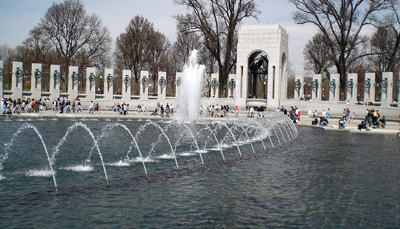 |
“It was too long,” George Kersites, a park service volunteer at the information desk at the memorial said. “But I think the finished product somewhat makes up for the lost time that it took to build.”
The memorial is deeply saturated with symbolic meaning.
The World War II Memorial is maintained by the National Park Service and is located between the Washington Monument and the Lincoln Memorial on the National Mall, reflecting the importance of World War II in preserving and internalizing democratic ideals won under George Washington and defended under Abraham Lincoln.
The constructed memorial covers 2.5 acres and is constructed of bronze and granite. Granite was chosen for its aesthetic appeal, strength and durability while bronze represents peace.
On each side of the memorial’s ceremonial entrance, located on 17th Street, are 12 sculptural scenes depicting of America at war. One scene, for example, illustrates a family gathered around a radio to hear President Franklin D. Roosevelt declare war on Japan after the bombing of Pearl Harbor.
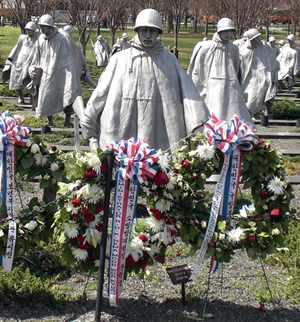 |
Wreaths honor the memory of the soldiers who fought in the Korean War at the Korean War Memorial (Photo by David Lake). |
The 56 pillars represent the states and territories that came together during war and are bound together by a bronze rope. The pillars are arranged in the order of entry into the Union progressing south to north beginning adjacent to the Field of Gold Stars
Most of the visitors take pictures with their home-state inscribed. “I like how the WWII Memorial recognizes the efforts of each state because it truly was a national war,” Mary Hook, 56 of Peoria, Illinois said as she took a picture with the Illinois pillar.
Hanging on both sides of each pillar are oak and wheat bronze wreaths, symbolizing the importance and success of the nation’s industrial and agricultural strength.
On the western side of the memorial, behind a reflection pool is a Freedom Wall recognizing the sacrifice of America’s World War II generation and the contribution of the allies.
On the wall are 4,000 sculpted gold stars, commemorating the 400,000 Americans who gave their lives. The gold star was the symbol of family sacrifice during the WWII era. Inscribed at the base of reflection pool reads: “Here we mark the price of freedom.”
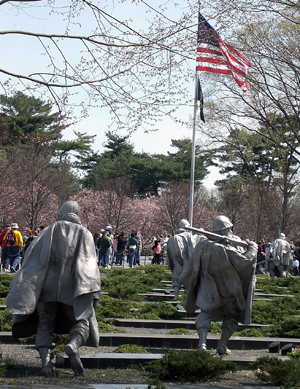 Most visitors face the Freedom Wall with their heads bowed in a prayer-like manner whey they arrive at the wall. “The wall is very powerful,” Robert Jenkins, 44, of Richmond, Virginia said. “The gold stars make you remember the sacrifice of all the soldiers.”
Most visitors face the Freedom Wall with their heads bowed in a prayer-like manner whey they arrive at the wall. “The wall is very powerful,” Robert Jenkins, 44, of Richmond, Virginia said. “The gold stars make you remember the sacrifice of all the soldiers.”
On the north and south sides of the memorial are two 43-feet pavilions representing the battles won on the shores of the Atlantic and Pacific oceans. The pavilion spills into a step fountain, with each country on the Atlantic or Pacific coast named.
Within each pavilion are four American eagles, holding a suspended victory laurel to honor the victory of the World War II generation.
On the floor of these pavilions is the World War II victory medal surrounded by the years 1941-45 and the words “Victory on Land, Victory at Sea, Victory in the Air.”
Rooted the middle of the memorial is a 246-feet long and 147-feet wide Rainbow Pool which features two large fountains on the north and south side of the pool. The design of the Rainbow Pool allows for seating along the circumference of the pool.
“This is a great place to sit and remember the soldiers that fought in World War II,” Katie Price, a 17 year old student from Boston said. “I think that the water is a good place for reflection.”
A 10-minute walk west from the World War II memorial, just before the Lincoln Memorial is the Korean War Veterans Memorial.
The Korean Memorial, which opened in July of 1995, eerily captures the perils of war, while remembering those who served. Viewed from above, the memorial is a circle intersected by a triangle. Visitors approaching the memorial come first to the triangular Field of Service.
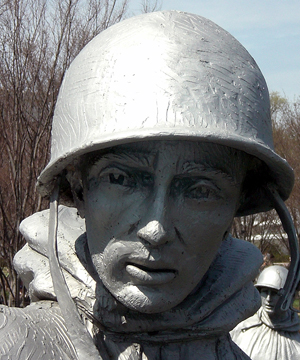 A group of 19 stainless steel statues created by World War II veteran Frank Gaylord depicts a squad on patrol and evokes the experience of American ground troops in Korea. Strips of granite and scrubby juniper bushes suggest the rugged Korean terrain.
A group of 19 stainless steel statues created by World War II veteran Frank Gaylord depicts a squad on patrol and evokes the experience of American ground troops in Korea. Strips of granite and scrubby juniper bushes suggest the rugged Korean terrain.
“The faces of the soldiers are harrowing,” Abigail Williams, 46, of Jackson, Miss., said of the Air Force, Army, Marines and Navy men portrayed. “War has definitely affected them.”
It appears the soldiers are marching toward the flag pole that is placed at the apex of the triangular field the soldiers are hiking through—the United States flag representing the American freedoms the soldiers are working toward preserving.
A granite curb on the north side of the statues lists the 22 countries of the United Nations that sent troops or gave medical support in defense of South Korea. On the south side of the memorial is a black granite wall with a polished surface that mirrors the statues, fusing the reflected images with the faces etched into the granite.
The etched mural is based on actual photographs of unidentified American soldiers, sailors, airmen, and marines. The faces represent all those who provided support for the ground troops.
When visitors look at the granite wall up close, they can see there reflection along with the photos of the soldiers. “The reflection made me think that if I grew up in that era those soldiers could have been me,” Andrew Gagliano, 32, of Charlotte North Carolina said. “It really put me in the soldier’s shoes.”
At the point of the triangle and adjacent to the wall is the Pool of Remembrance encircled by a grove of trees. Numbers of those killed, wounded, missing in action, and held prisoner of war are etched in stone nearby.
“The Korean War Memorial is a successful memorial because it really makes the visitors to remember,” Ranger Gayle W. Lyons said. “It is a little dark, but that is what strikes the visitors most.”
| The soldiers of the Korean War Memorial (Photo by David Lake). | 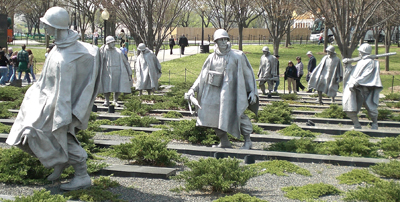 |
Opposite of the wall counting the war tolls is a granite wall bearing the chilling message inlaid in silver: “Freedom Is Not Free.”
Freedom may not be free, but the price the fallen World War II and Korean War soldiers paid was priceless to America’s liberty.
If You Go
- Location: The WWII Memorial is located on 900 Ohio Drive S.W. in the National Mall. The Korean War Memorial is a 10-minute walk west of the World War II Memorial.
- Fees: Both memorials are free.
- Hours: The memorials may be visited 24 hours a day. Both memorials offer information stations that are staffed by park rangers and volunteers from 9:30 a.m. to 11:30 p.m. everyday except Christmas.
- To gain a different perspective on the memorials, try visiting at night. The memorials emanate a different tone in the darkness when illuminated by the lights.
- Parking: Parking is tough to come by in the National Mall area, but you can try the general visitor parking that is available along Ohio Drive between the Lincoln and Jefferson Memorials. You can also take the orange or blue line of the metrorail system at the Smithsonian stop in the National Mall, which lets out a little less than a mile walk east of the World War II Memorial.
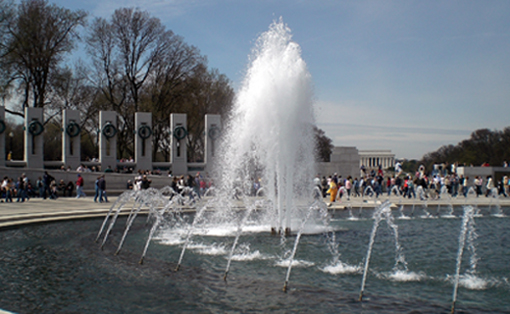 |
| Visitors walk around the World War II Memorial fountain. The Lincoln Memorial on the National Mall can be seen in the background (Photo by David Lake). |

Comments are Closed